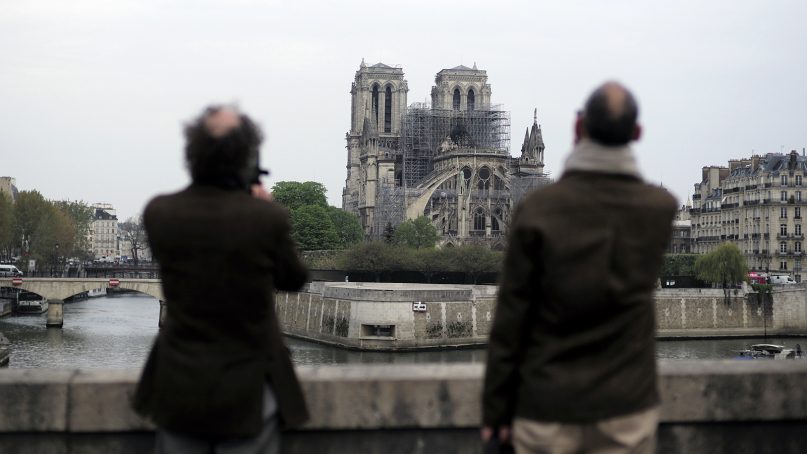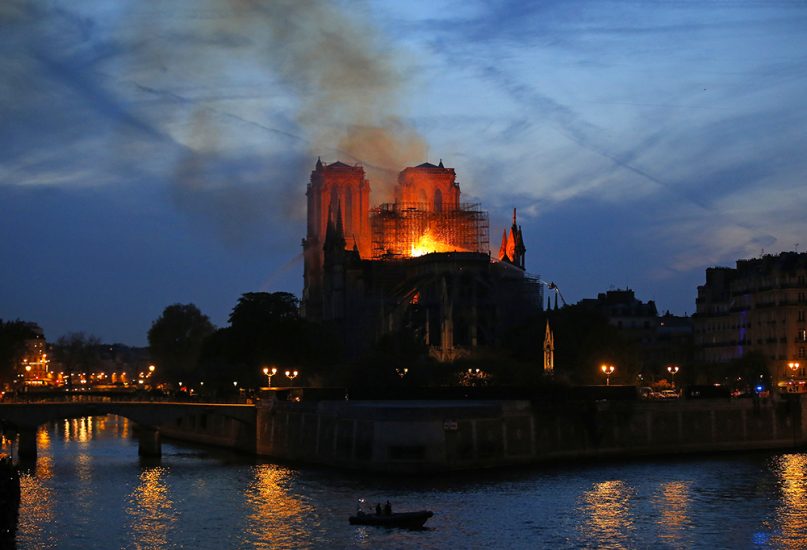(RNS) — The only time I visited Notre Dame was in the winter of 1985.
We were inside the storied cathedral, and I noticed that a baptism was taking place.
The priest was totally focused on the sacred ritual. So was the mother. So were the grandparents, whose faces were beaming.
But, not the father. His hands were stuffed nervously into his pockets. His eyes were wandering. He wanted, it seemed, to be anywhere but there.
That moment was pivotal for me and for my spiritual development. I realized that far too many people enter the sacred moments of their lives — not as pilgrims, but as tourists. I realized that far too many people simply cannot focus on the sacred.
I was probably a tad too judgmental and, most likely, wrong.
I assumed that the father was apathetic.
More likely: His focus was on a different level of holiness — the holiness and the grandeur of the place itself. Perhaps his focus was on the intricacy of the stained glass itself, which depicts various biblical scenes, the full meaning of which would take years to unpack.
Who could blame him?
It is all so sad — to see flames engulf the Notre Dame Cathedral, to see the famed building’s central spire falling, and its roof collapsing.
Notre Dame is one of the most famous buildings in the world. It has served as a religious symbol for more than 800 years. Notre Dame has been Paris’ most-visited monument. Over 12 million people visit the cathedral annually, nearly double the number that visit the Eiffel Tower.
How can Jews mourn Notre Dame?
It sounds like a strange question.
This was not “our” place; quite the contrary. Some of its symbolism reflected medieval anti-Semitism.
Consider the twin female figures of Ecclesia et Synagoga (church and synagogue). The proud, upright woman represents the church triumphant. The blindfolded woman with the broken sword represents Judaism. That was how even and especially the illiterate learned how to hate Jews and Judaism.

People stop to see and photograph the Notre Dame Cathedral after the fire in Paris, on April 16, 2019. Experts are assessing the blackened shell of Paris’ iconic cathedral to establish next steps to save what remains after a devastating fire destroyed much of the 850-year-old building. (AP Photo/Kamil Zihnioglu)
Nevertheless, we Jews can and should mourn.
We mourn, because Notre Dame is a sacred place. Even in a rapidly secularizing world (and even, ironically, in France, the country that gave birth to European secularism), holy places still matter.
Holy places matter to us as Jews, despite Abraham Joshua Heschel’s preference for sacred time over sacred place.
In The Sabbath, Heschel notes that the word kadosh (holy) appears for the first time to describe time (Shabbat) rather than space:
Judaism is a religion of time aiming at the sanctification of time. … Judaism teaches us to be attached to holiness in time, to be attached to sacred events, to learn how to consecrate sanctuaries that emerge from the magnificent stream of a year. The Sabbaths are our great cathedrals; and our Holy of Holies is a shrine that neither the Romans nor the Germans were able to burn; a shrine that even apostasy cannot easily obliterate.
I think that Heschel overstated the case.
I noticed this the other day while praying at services.
The Shabbat morning service begins with Ma Tovu — “How good are your tents, O Jacob … ” It is a collection of snippets of Psalms, each one mentioning words like “house,” “temple,” “dwelling-place.”
Yes, place matters.
In the past year, we have seen willful, bloody defilements of several holy places: the murders at Tree of Life Synagogue in Pittsburgh, and the horror of the attacks on the mosques in Christchurch, New Zealand.
L’havdil (there is a difference): The attack on Notre Dame was an accident.
But even still, the omnipresent mourning — even the fact that people are posting their own old tourist photos of the cathedral on Facebook — testifies to the fact that the idea of holy places has not vanished from this world.
We mourn, because Notre Dame symbolizes human creativity. Anyone who has visited Notre Dame can only gawk in awe over its splendor. That splendor emerged from the human mind, and from the human hand — as elements of the human spirit, which itself is an imitation of the divine spirit of creativity. In constructing grand structures, we testify to our ability to be creators of worlds.
We mourn, because Notre Dame symbolizes transcendence.To be blunt and obvious: They don’t build places like that anymore. At least, not churches and synagogues. The builders of Notre Dame, along with other sacred places of its genre, intended for both worshippers and mere tourists to understand a central message: You, oh mortal, are small; God is great. The hidden lesson was humility, and that you could reach for something larger, grander and holier.
We don’t do that anymore. Our religious buildings don’t look like Notre Dame, or Temple Emanu-El in New York City, for that matter. Sanctuaries are smaller. The ceilings are lower.
Are there still structures that command that kind of awe?
The good news is: Yes.
The bad news is: They tend to be shopping malls.
We mourn the countless prayers that worshippers uttered there. Can you begin to imagine that number?
Then, try imagining the number of grains of sand on a beach.
Perhaps “mourn” is the wrong word. Surely, those words ascended to the heavens, to the very ear of God, if I can be audacious enough to say that.
I am in awe, nevertheless, of the countless human emotions that have accompanied worshippers into that sacred space. Gratitude, pain, devastation, hope; the number of languages of those prayers; the beautiful hymns and music that that sacred space has heard since the 13th century.
Each prayer represented a human soul, made in the divine image.
We mourn with our Catholic friends and relatives.There was a time — and it was not that long ago — that Jews and Christians and Muslims would have scarcely cared about damage to the sacred places of the other. Those days are gone. We do care. This was one of God’s dwelling places. That it happened coincident with Holy Week only adds to the cruelty.
In a world that strives for shalom, we reach our hands out to France and Catholics everywhere.
We mourn, and mourning always means that there is hope. Officials have saved the cathedral from total destruction.
To quote the late Leonard Cohen (who was probably speaking of the ancient altar in Jerusalem): “Come healing of the altar; come healing of the Name.”
The altar of Notre Dame was untouched, unscathed. Its surrounding space will be healed. And with it, the Name of God will be healed, because God surely wept at this destruction.
I am mindful of the Hasidic saying: “If you want to find a spark, sift through the ashes.”
In this sacred season of longing and liberation, may we all find the sparks that will help us rise above the mundane.






